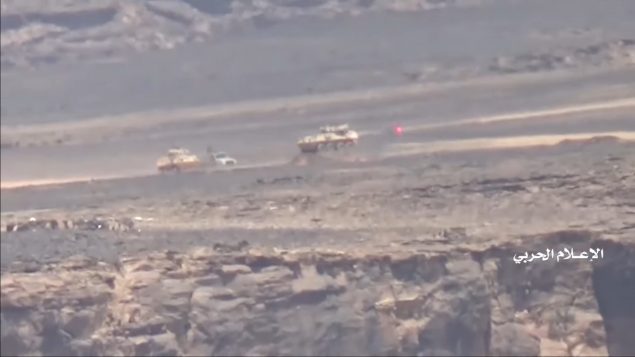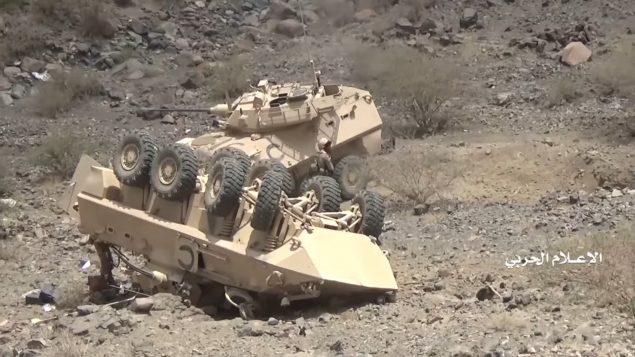Canadian government officials are “closely” reviewing recently released video footage that appears to show Canadian-made Saudi military equipment captured or destroyed by Houthi rebels in Yemen, says a spokesperson for Foreign Affairs Minister Chrystia Freeland.
Video footage and still images released by the Houthis on Sept. 29 and throughout last week appear to show at least twelve damaged or destroyed light armoured vehicles (LAVs) of various models produced by General Dynamics Land Systems – Canada (GDLS-C) in London, Ontario, along with other armoured vehicles and large quantities of light weapons and ammunition.
The materials released by the Iran-backed Houthi movement also show nine damaged Spartan armoured personnel carriers produced by the Canadian-owned Streit Group, which is now based in the United Arab Emirates, and four IAG Guardian armoured personnel carriers, produced by the Toronto-based International Armored Group.
The Houthis claim the footage, an edited compilation of several videos, shows the results of a major 72-hour military offensive by their forces against the Saudi-led coalition.

An image grab from a video released by the Houthi movement purports to show a Canadian-made LAV-25 operated by Saudi forces about to be hit by an anti-tank missile in the region of Wadi al-Faraa on Sept. 2, 2019. (Houthi Military Media/Handout)
Radio Canada International could not independently confirm this information and Saudi Arabia has officially denied claims that hundreds of its soldiers and allied forces were killed in the rebel offensive and thousands surrendered to the Iran-backed Houthis.
“Any time we are made aware of videos like this one, we review them closely to determine where and when they were taken as well as which vehicles appear in them,” Adam Austen, Freeland’s press secretary, told Radio Canada International in an email on Friday. “Officials at Global Affairs Canada are in the process of doing so for this video.”
Doug Wilson-Hodge, a spokesman for General Dynamics Land Systems-Canada, told Radio Canada International the company is declining to comment on the footage.
However, experts consulted by Radio Canada International identified the vehicles in the still images and the video released by the Houthis as Canadian-produced LAV-25s and a Bison armoured personnel carrier, which is also based on the LAV-25 platform.

An image grab from a video released by the Houthi movement shows a Canadian-made LAV allegedly destroyed by Houthi fighters in the Wadi al-Faraa region on Sept. 2, 2019. (Houthi Military Media/Handout)
Critics of Ottawa’s multibillion arms sales to the oil-rich kingdom say the footage demonstrates once again that Canadian-made equipment bought by Riyadh over the last 25 years ostensibly to defend Saudi Arabia from aggressive neighbours such as Iraq and Iran is instead being used in an offensive war in Yemen.
A coalition of Canadian advocacy and human rights groups is calling on the federal government to cancel a controversial $15-billion contract to supply Saudi Arabia with the latest model of LAVs.
Austen said the federal government has taken “firm action” to strengthen Canada’s arms export controls system by passing legislation that enshrines human rights into federal export laws.
On Sept. 17, 2019, Canada officially became a state party to the United Nations Arms Trade Treaty, he added.
“This means that there is now a new legal requirement that the Canadian government must deny export permits if there is a substantial risk that the export would result in a serious violation of human rights, including serious acts of gender based violence,” Austen said.
“As we have said before, a review of all export permits to Saudi Arabia is on-going and no final decision has been made. During this review, no new permits have been issued.”

An image grab from a video released by the Houthi movement allegedly shows two Saudi light armoured vehicles (LAVs) destroyed by the rebels in an August offensive in the Kitaf district in northern Yemen. Radio Canada International could not independently confirm the location of the photo, but experts consulted by RCI identified the vehicles as LAVs produced by General Dynamics Land Systems – Canada at their plant in southern Ontario. (Houthi Military Media/Handout)
However, the federal government has not stopped the export of the newest model of Canadian LAVs or upgrade kits for the older models of LAVs, imported by Saudi Arabia since the early 1990s.
The Liberal government approved the controversial deal, signed by the previous Conservative government, to supply the Islamic Kingdom with hundreds of LAV 6.0 advanced combat vehicles in 2016.
According to a declassified 2016 memo prepared by Global Affairs Canada for then foreign affairs minister Stephane Dion and released by the government with several redactions following a legal challenge in the Federal Court, GDLS-C had applied for six new permits worth about $11 billion dollars for the new LAV 6.0 variants, as well as upgrade kits for the older versions, such as the LAV-25s.
The number of new LAVs Saudi Arabia wants to purchase and their associated armaments are redacted out in the memo.
However, between 1993 and 2015, the federal government granted GDLS-C permits to export more than 2,900 LAVs and their associated weapons systems, including automatic canons, assault guns, mortars and anti-tank missiles, the memo said.







For reasons beyond our control, and for an undetermined period of time, our comment section is now closed. However, our social networks remain open to your contributions.